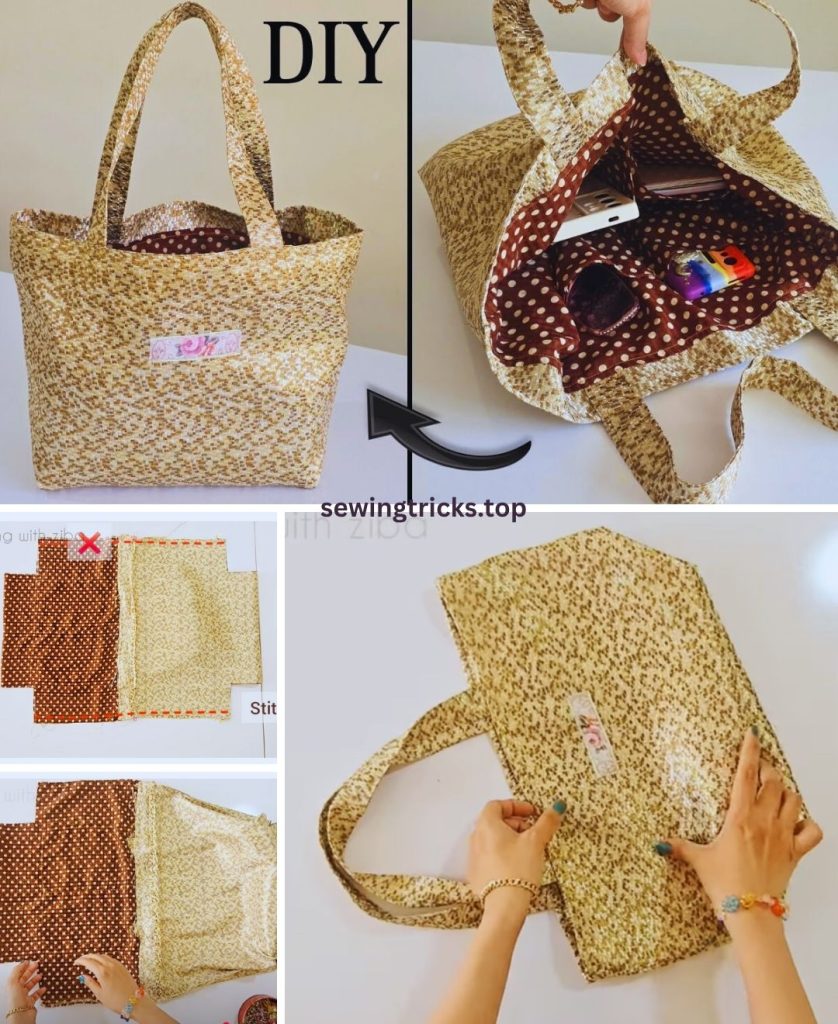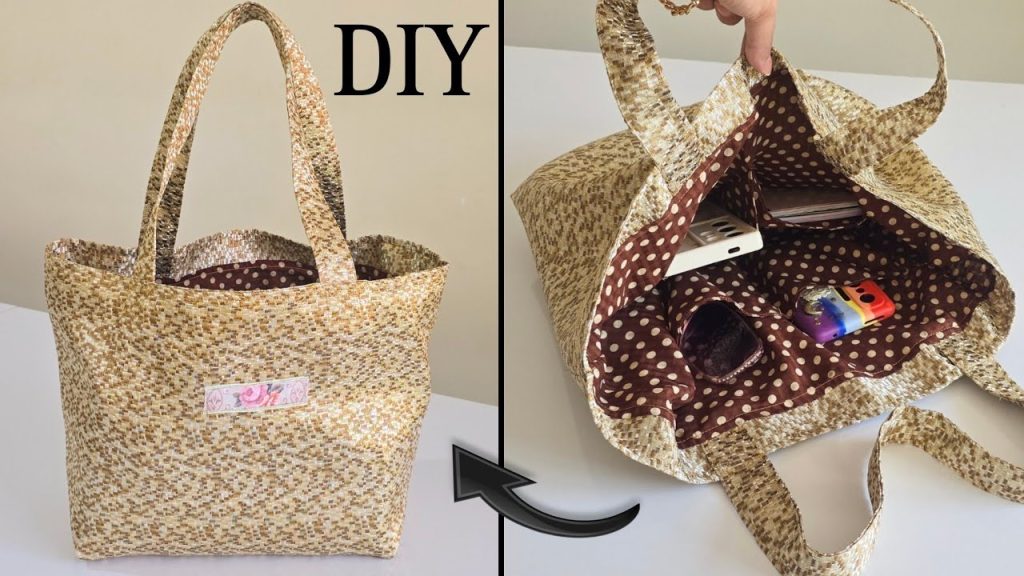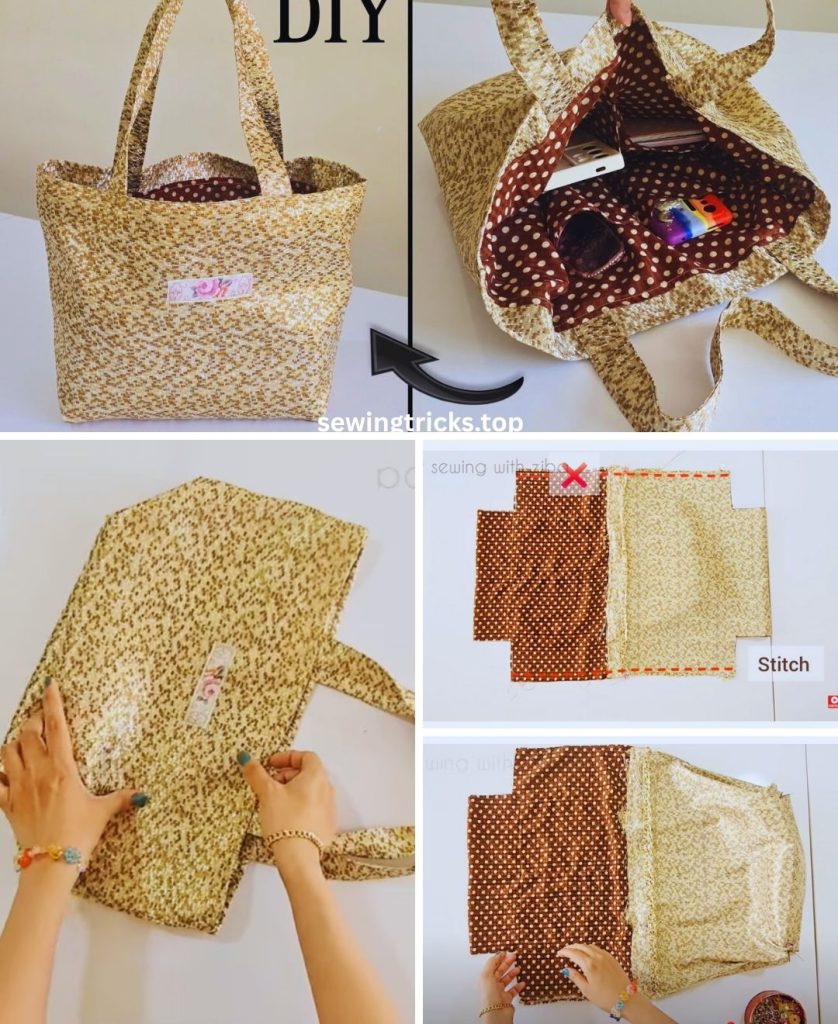You’ve picked a fantastic project! Making a tote bag with a lining elevates it from a simple, casual carry-all to a more polished, durable, and functional accessory. The lining hides raw seams, provides extra strength, and often includes interior pockets for better organization. This is a very satisfying project that results in a professional-looking bag you’ll be proud to use.
Let’s dive into making a classic, sturdy tote bag with a flat, boxed bottom and a full lining, including an optional interior slip pocket.
How to Make a Tote Bag with Lining
This detailed guide will walk you through each step, ensuring you understand the techniques for a well-constructed and beautiful bag. We’ll use a 1/2-inch (1.27 cm) seam allowance for all sewing unless otherwise stated.

I. Planning Your Lined Tote Bag
Careful planning makes all the difference for a successful sewing project.
- Size: Think about how you’ll use your tote. A versatile medium-large size is often around 14 inches wide x 15 inches tall x 4 inches deep (35.6 cm x 38.1 cm x 10.2 cm). This size is great for groceries, books, daily essentials, or a craft project.
- Fabric Choices:
- Exterior Fabric (Main Bag): Choose a medium to heavy-weight fabric for durability and structure. Excellent options include canvas, duck cloth, denim, home décor fabric, twill, or corduroy. A fun print or a classic solid will work beautifully.
- Lining Fabric: A medium-weight quilting cotton, broadcloth, or poly-cotton is perfect. Pick a color or print that complements your exterior fabric, or go bold for a fun pop of color when you open the bag!
- Stabilizer (Optional but Recommended for Structure): If your exterior fabric isn’t very stiff (e.g., a lighter-weight cotton), you might want to use a fusible fleece (like Pellon 987F) or heavyweight fusible interfacing (like Pellon 809 Decor Bond) on the exterior panels. This will give your tote a firmer shape and help it stand up on its own.
- Handles:
- Fabric Handles (from matching exterior fabric or a contrasting solid): This creates a cohesive look.
- Webbing Handles: Cotton or polyester webbing (1-inch to 1.5-inch wide) is super durable and often used for totes.
- Optional Features:
- Interior Slip Pocket: Very useful for organizing small items like keys, phone, or a pen.
II. Gather Your Materials
Having everything ready before you start will make your sewing process smooth and efficient.
- Exterior Fabric: 1 to 1.5 yards (0.9 to 1.4 meters), depending on bag size and fabric width.
- Lining Fabric: 1 to 1.5 yards (0.9 to 1.4 meters), same as exterior.
- Handle Material:
- For Fabric Handles: An additional 1/2 yard (0.45 meters) of exterior or coordinating fabric.
- For Webbing Handles: 1.5 to 2 yards (1.4 to 1.8 meters) of 1-inch or 1.5-inch wide cotton or polyester webbing.
- Stabilizer (Optional): 1 to 1.5 yards (0.9 to 1.4 meters) of fusible fleece or heavy-duty fusible interfacing.
- Matching Thread: All-purpose polyester thread.
- Basic Sewing Supplies:
- Sewing Machine (with a walking foot if sewing thick fabrics/layers)
- Sharp Fabric Scissors or Rotary Cutter and Mat
- Long Quilting Ruler or Measuring Tape
- Fabric Chalk or Mark-B-Gone Pen
- Plenty of Pins or Fabric Clips (clips are great for thick layers!)
- Iron and Ironing Board (essential for crisp seams and fusing interfacing)
- Seam Ripper (everyone needs one for inevitable “oops” moments!)
III. Plan Your Cuts & Prepare Your Fabric Pieces
Accuracy in cutting is key for a well-fitting bag. Pre-wash and press all your fabrics before cutting to prevent shrinkage later.
A. Determine Your Panel Sizes (Example: 14″ W x 15″ H x 4″ D Tote):
We’ll add our 1/2-inch (1.27 cm) seam allowance to all dimensions.
- Main Body Panel Width: Finished Width + Finished Depth + (2 * Seam Allowance) = 14″ + 4″ + 1″ = 19 inches (48.3 cm)
- Main Body Panel Height: Finished Height + Finished Depth + (2 * Seam Allowance) = 15″ + 4″ + 1″ = 20 inches (50.8 cm)
B. Cut Your Fabric Pieces:
- Exterior Fabric:
- Main Body: Cut 2 rectangles, each 19 inches wide x 20 inches high.
- Handles (if using fabric): Cut 2 rectangles, each 4 inches wide x 25 inches long (adjust length for desired handle drop, 25″ is a good general length).
- Lining Fabric:
- Main Body: Cut 2 rectangles, each 19 inches wide x 20 inches high.
- Interior Slip Pocket (Optional): Cut 1 rectangle, 10 inches wide x 12 inches high.
- Stabilizer (Optional):
- Main Body: Cut 2 rectangles, each 18 inches wide x 19 inches high (1 inch smaller on all sides than your main panels to keep bulk out of the seams).
IV. Let’s Start Sewing Your Lined Tote Bag!
General Sewing Tips:
- Press as you go! This is crucial for professional-looking results.
- Use plenty of pins or clips. They prevent fabric from shifting, especially with multiple layers.
- Backstitch at the beginning and end of every seam to secure your stitches.
- Use a regular stitch length (around 2.5 mm). If sewing very thick fabric, you might lengthen it slightly (3.0-3.5mm).
- If your machine struggles with thick layers, use a walking foot (highly recommended for tote bags).
Step 1: Prepare Exterior Panels (Fuse Stabilizer)
- Take your two Exterior Fabric Main Body Panels. Lay each one wrong side up on your ironing board.
- Center and fuse the corresponding Stabilizer piece to each exterior panel, following the manufacturer’s instructions. Press firmly and allow to cool completely. This is what will give your tote its lovely structure.

Step 2: Sew the Exterior Bag Body
- Place the two Exterior Fabric Main Body Panels right sides together, carefully aligning all raw edges.
- Pin securely along both side edges and the entire bottom edge. Leave the top edge open.
- Using your 1/2-inch (1.27 cm) seam allowance, stitch from one top corner down that side, pivot sharply at the bottom corner, stitch straight across the bottom, pivot again, and stitch up the other side to the top corner. Backstitch at the beginning and end of your seam.
- Press your seams open thoroughly to reduce bulk.
Step 3: Box the Corners of the Exterior Bag
This step creates the flat, defined bottom of your tote bag.
- Lay the exterior bag body flat. The side and bottom seams should be pressed open.
- At one of the bottom corners, carefully bring the side seam and the bottom seam together, aligning them perfectly. This action will naturally form a triangular shape at the corner.
- Measure from the tip of this triangle inward along the seam line a distance equal to half of your desired bag depth (e.g., for a 4-inch deep bag, you’ll measure 2 inches / 5 cm).
- Draw a straight line perpendicular to the seam at this measured point. This is your new stitching line.
- Pin firmly along this drawn line.
- Stitch precisely along the drawn line, backstitching securely at both ends.
- Trim the excess fabric from the corner, leaving about a 1/2-inch (1.27 cm) seam allowance beyond your new stitching line.
- Repeat this exact process for the other bottom corner of your exterior bag body.
- Result: Your exterior bag now has a structured, flat bottom. Keep it wrong side out.
Step 4: Prepare and Attach Fabric Handles (Skip if using webbing)
- Take one of your fabric handle strips (4″ x 25″).
- Fold it in half lengthwise, wrong sides together, and press firmly. Open it up.
- Fold each long raw edge in towards the center crease you just made, and press again.
- Fold the entire strip in half again along the original center crease. You should now have a long, flat handle that is about 1 inch (2.5 cm) wide with no raw edges visible. Press firmly along the entire length.
- Topstitch down both long sides of the prepared handle, about 1/8 inch (0.3 cm) from the edge. This secures all the folds and makes a neat, strong handle.
- Repeat this process for the second handle strip.
Step 5: Sew the Lining Bag Body (with Optional Pocket)
The lining is constructed almost identically to the main bag, with one crucial difference for turning the bag right side out.
- Prepare Interior Slip Pocket (Optional):
- Take your 10″ x 12″ pocket piece.
- Fold it in half, right sides together, so it’s 10″ x 6″. Stitch the sides and bottom, leaving a 3-4 inch (7.6-10.2 cm) opening on the bottom. Trim corners.
- Turn the pocket right side out through the opening. Push out corners, press flat. Stitch the opening closed by machine (very close to the edge) or by hand.
- Position and Attach Pocket: Take one of your Lining Fabric Main Body Panels. Position the pocket about 4-5 inches (10-12.7 cm) down from the top raw edge, and centered horizontally.
- Topstitch the pocket to the lining panel along its two sides and bottom edge. Stitch close to the edge. Reinforce the top corners of the pocket with a small triangle stitch or a few back-and-forth stitches.
- Sew Lining Body:
- Place the two Lining Fabric Main Body Panels right sides together, aligning all raw edges.
- Clip or pin along both side edges.
- CRUCIAL STEP: For the bottom seam, you must leave an opening! Stitch down one side seam. Then, for the bottom seam, stitch approximately 3 inches (7.6 cm) from one side, then leave a 4-6 inch (10-15 cm) unstitched gap in the middle of the bottom seam. This opening is absolutely essential for turning the entire bag right side out later. After the gap, stitch for another 3 inches (7.6 cm) to reach the other side seam. Backstitch well at the start and end of the stitched sections around your opening.
- Stitch up the second side seam.
- Press your seams open.
- Box the Corners of the Lining Bag: Box the corners of your lining bag using the exact same method you used for the exterior bag (refer back to Step 3).
- Result: Your lining bag is now fully constructed, with that important turning opening. Keep it wrong side out.

Step 6: Attach Handles to Exterior Bag
- Turn your exterior denim bag right side out.
- Lay the bag flat, smoothing it out.
- Measure in from each side seam along the top raw edge by about 4-5 inches (10-12.7 cm). Mark these points with chalk. These marks indicate where your handle ends will be placed.
- Take one prepared handle (fabric or webbing). Position its raw ends on the top raw edge of the bag at your marks. Make sure the handle itself is flat and not twisted. Pin securely.
- Stitch the handle ends in place. For a strong hold, sew a small square (about 1×1 inch) with an “X” inside it (an X-box stitch) for maximum reinforcement. Stitch within the 1/2-inch (1.27 cm) seam allowance, close to the edge.
- Repeat for the other side of the bag with the second handle.
Step 7: Join the Exterior Bag and the Lining Bag (The “Bag-in-a-Bag” Method)
This clever technique encloses all raw edges at the top for a super clean and professional finish.
- Ensure your exterior bag is right side out, with handles attached and pointing down into the bag.
- Ensure your lining bag is wrong side out (and still has that turning opening at the bottom).
- Carefully insert the exterior baginto the lining bag.
- The right sides of both bags should now be facing each other.
- Align the side seams of the exterior bag with the side seams of the lining bag.
- Align the top raw edges of the exterior fabric and the lining fabric all around the entire opening of the bag. The handles should be sandwiched between the layers, pointing down.
- Clip very securely all the way around this top edge, matching up seams precisely.
- Using your 1/2-inch (1.27 cm) seam allowance, stitch all the way around the entire top opening of the bag. Go slowly and carefully, especially when you go over the handle attachment points. Backstitch at the beginning and end of your seam.
- Trim Bulk: Carefully trim the seam allowance at the top down to about 1/4 inch (0.6 cm) to reduce bulk inside the top edge.
Step 8: Turn Your Bag Right Side Out & Finish
This is the incredibly satisfying moment your tote bag takes its final, beautiful shape!
- Reach through the opening you left in the bottom seam of the lining.
- Slowly and carefully pull the entire bag (exterior, lining, handles – everything!) through this opening until it is completely right side out. Take your time, gently pushing out all the corners for a crisp, well-defined shape.
- Close the Lining Opening: Go to your ironing board. Press the raw edges of the opening in the bottom of the lining under by 1/2 inch (1.27 cm) so they meet neatly. Align these pressed edges and clip them together. Stitch this opening closed by machine (sewing very close to the folded edge for a neat finish) or by hand using an invisible ladder stitch for a truly seamless look.
- Now, push the lining down into the exterior denim bag.
- Final Press & Topstitch: Carefully press the entire top edge of the bag. Make sure the lining is fully tucked inside and isn’t peeking out over the top edge of the exterior fabric.
- For a super polished and durable finish, topstitch all around the entire top opening of the bag, about 1/8 inch (0.3 cm) from the edge. This final topstitching marries the lining to the exterior, helps the bag hold its shape, and creates a crisp, professional look. You can also sew a second row of topstitching about 1/2 inch (1.27 cm) from the top edge for added detail and stability.
Your beautifully lined tote bag is now complete! You’ve created a functional, durable, and stylish accessory that will serve you well for years to come. Enjoy using your handmade creation!




